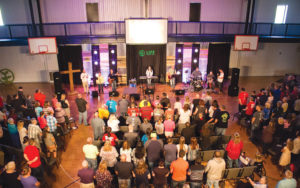 [1]
[1]
Most pastors wouldn’t consider it a landmark day when a fire destroys a church’s office space and future ministry hub.
But Kenny Rager does.
In May of 2016, a fire ravaged the storefront offices that Life Community Church in Owensboro, Kentucky, had hoped to turn into a space for local student ministry efforts. Although the four-year-old church plant met at a local community college for worship services, the loss of office space could have been devastating.
“It felt like our future was taken from us,” Rager said. “Little did we know that God was going to use a fire not to take away our future but to give us a future.”
Churches throughout Owensboro contacted Life Community to see how they could help the four-year-old church plant. One of those churches was Hall Street Baptist Church, which offered to let Life Community use part of their building as temporary office space.
Hall Street was clearly in decline. For three months, the gifts Life Community gave to the church in gratitude literally kept the lights on.
That’s when Hall Street leaders came to Rager with an offer. The 108-year-old Hall Street Baptist Church was dissolving and wanted to give its building to Life Community at no cost.
At first, Rager turned it down. Instead, he wanted to help Hall Street restructure and restart. But the Hall Street leadership was ready to pass on the building and move on.
Not only did Hall Street give the young church plant a sanctuary that held six hundred people but also a fifteen-year-old Christian Life Center that included a full-size basketball court.
After a little more than a year in the building, the church has grown from two hundred regular attendees to three hundred.
Mark Clifton, the senior director of replanting for the North American Mission Board (NAMB), says Life Community’s story illustrates a larger trend in Southern Baptist life.
“The story of replanting churches in North America is an answer to the prayers of so many Christians,” Clifton said. “For years, we’ve been praying that God would resurrect dying churches. That’s what we’re seeing as dying churches like Hall Street hand off their buildings to new church plants like Life Community. In my lifetime I’ve never seen growing, healthy churches demonstrate such a passion for helping struggling churches. It has to be an answer to prayer.”
Last year alone, NAMB identified 135 churches involved in a replanting process, but that number is likely just a fraction of the real total. Clifton says NAMB doesn’t have a complete picture of how many churches are involved in replanting today. In fact, Clifton didn’t hear about Life Community’s story until early 2018.
Nearly one thousand Southern Baptist churches drop off the SBC database each year, many because they are closing their doors forever. Without a strategic replanting process in mind, many of these congregations would give or sell their properties to other local establishments—from worship halls for other faiths to bars and restaurants.
Clifton believes this is tragic.
“The church is today, more than ever, a bulwark of truth,” Clifton said. “We need every church. We can’t lose them. God is using replanting to make sure this happens.”
This is why Paul Chitwood, executive director-treasurer of the Kentucky Baptist Convention (KBC), helps churches like Life Community throughout the replanting process.
“Our KBC staff was also blessed to assist when the growing Life Community congregation began conversations with Hall Street Baptist Church about the Hall Street property being given over to Life Community,” Chitwood said. “It was a beautiful picture of the kind of sacrificial generosity that allowed the resources of a struggling church to remain in the Baptist family and be used to richly bless a young, growing church. Now in the hands of Life Community, the Hall Street property has once again become a thriving force for the Gospel in Owensboro. We hope to see more sacrificial gifts like this one rather than church buildings being abandoned or sold.”
Local associations, state conventions, and NAMB all play a role in helping dying churches either find new life as a congregation, merge with a healthy church, become a campus of a larger church, or, as in the case of Hall Street Baptist Church, pass on their building to a new church plant.
But no matter which avenue a church goes down, replanting begins with a struggling church making a courageous decision.
“Replanting starts with a church’s realization that they can no longer do ministry as they’ve been doing it and expect new results,” said Bob Bickford, NAMB’s associate director of replanting. “It’s not about a program or a study or a new promotional piece sent out to the community.
It’s not about inviting people to come to a church for a program or a service or an event. It’s about a church being honest before God and saying what we’ve been doing hasn’t been working.”
NAMB provides a number of resources to help raise the visibility of replanting throughout the Southern Baptist Convention, including a new podcast hosted by Clifton and LifeWay Christian Resources President Thom Rainer. Each episode of “Revitalize and Replant” focuses on a different issue facing those involved in the replanting process. Past topics have included the characteristics of an effective church replanter, unseen signs of a declining church, and how to organize a replant.
“Our role nationally is to connect all the dots,” Clifton said. “We’re showing what God is doing through replanting and changing the old narrative—that dying churches are bad places to avoid. Dying churches are great places to go to and great places for God’s glory to be seen. We also do what we can to train state conventions and local associations to contextualize replanting in their area.”
For more information about NAMB’s church replanting efforts, visit www.namb.net/church-replanting.
